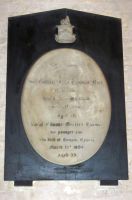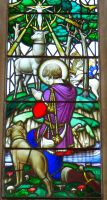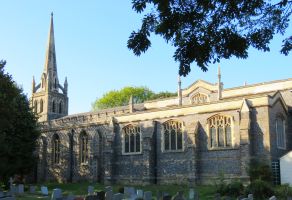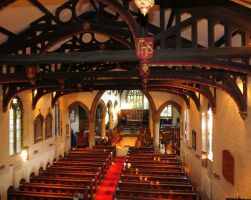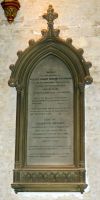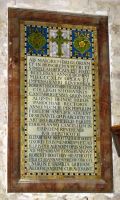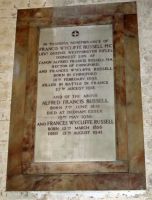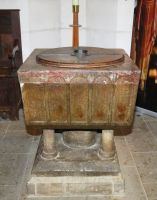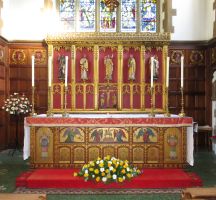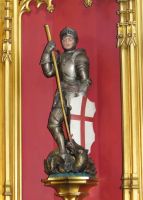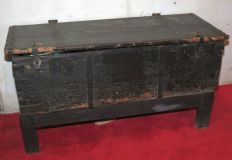Chingford St Peter & St Paul - Monuments
For this website, with its interest in monuments, Chingford Old Church (All Saints) is the more relevant, but the new church of St Peter & St Paul does include a very few monumental panels, the Norman font and a few bits from the old Church, and good end of the 19th Century furnishings. Chingford is part of Essex-in-London, the part of the County of Essex transferred to London to form the north east suburban boroughs.
The Church building
St Peter & St Paul Church, Chingford, was completed in 1844 by the interesting architect Lewis Vulliamy, after the old church - All Saints - fell into disrepair. The driving force was the rector, the Revd. Robert Boothby Heathcote, a wealthy man who, unusually, owned the living for the Parish. What we see today is a mix of style as conceived by Vulliamy, and an expansion in the 1890s by Reginald Blomfield, who most notably enlarged the chancel end.
St Peter & St Paul, Chingford.
The exterior of the Church is of banded and chequered flint, with honey-coloured stone dressings and bands. The main features are this flintwork, and the tower with its wilfully thin spire, held up by flying buttresses counter-weighted with pinnacles at the corners of the tower balustrade. Otherwise, the low body of the Church is straight-forward, symmetrical, with the three light windows of the several bays separated by nice buttresses, and crenelations above.
Inside, the Church is all warm earth colours, with parquet flooring, a full set of pews, pale stone pillars supporting arches separating the nave from the aisles, and clerestorey and exposed beam roofs above, which give much to the feel and ambience of the interior. We start with the several wall panels.
Monuments
Revd. Robert Boothby Heathcote, d.1865, Rector of Chingford for 35 years, and his first wife Elizabeth Bridget [Wells] Heathcote, d.1894, with short Biblical quotations. A characteristic Victorian Gothic panel, one of a pair. Thus the inscribed panel of white marble fills a blind Gothic window, with mouldings all round, and crocketed (‘toothed’) above with little carved Acanthus leaves, and three of them at the top forming a cross or fleur de lys. The sides have typical narrow Victorian Gothic attached pillars, and the base is deep and contains a row of quatrefoils. All this surround is of a pale sandstone, again typical.
Heathcote monuments - Gothic blind windows.
Next to the above, a similar panel to Charlotte [Sotheby] Heathcote, d.1845, second wife of the Revd. Heathcote, her son also Robert Boothby Heathcote, d.1892, and the latter’s wife, Jane Vere Heathcote, d.1895.
Sir Godfrey John Thomas, Baronet, d.1861, and his son Edmond Herbert Thomas, d.1894. A white-on-black panel monument, with the inscription, somewhat decayed, on a white marble oval, above which is the family shield of arms, on a black backing panel, somewhat pointed at the top, and supported on two small brackets. See picture at top of page.
Arts and Crafts panels.
A commemoration panel, not really a monument, noting that the Church was built in 1844 by the generosity of the Revd Robert Boothby Heathcote, afterwards Rector, enlarged in 1903 by Sir Arthur Blomfield, with the chancel built in the same year in memory of his wife Elizabeth Brigitte Heathcote and son Robert Boothby Heathcote and the latter’s wife Jane Vere Heathcote. A good Arts and Crafts panel, in mosaic and tile and alabaster. The inscription, in Latin, is on pale tile. Above, across and two stylised floral decorations in mosaic, blue and green and black and white and gold, characteristic colours of the period, and a thin mosaic border runs around the piece, within a gilt tile outer border with repeating pattern. The whole is set in a frame of pinky-brown alabaster, also most characteristic of the Arts and Crafts artists. Picture above left.
Lt. Francis Wycliffe Russell, d.1918, killed in battle in France, just 20 years old, and added later, his father, Rector of the Church, Alfred Francis Russell, d.1936, and mother Frances Wycliffe Russell, d.1941. Plain Arts and Crafts panel, with a double border of the same pinky brown alabaster we saw in the Revd. Heathcote memorial, and a tiny cross in a circle above the inscription. See picture above right.
Also in the Church
The Norman font, a great solid piece of granite-like stone taken from the old church, heavily veined in the top piece, tan below. It is square in cross section, though the basin of course is round. On the sides are lightly cut round-headed arches. It rests on a thick central column, quite short, with thinner columns towards the corners, not all original, and there is a stepped square base below, of which the upper portion looks original. Satisfyingly massive.
Good ancient furniture, including a chest-like bench with panelling, carved with arches, lozenges etc, and a simpler chest bound with iron, which is the 17th Century Parish chest from the old church - see picture at bottom of page. .
Altar, reredos and sample figures
A flamboyant altar table and reredos, painted and gilt. The front of the altar table has panels with angels – an inner pair kneeling to a Lamb of God, and an outer pair swinging censors – eyebrow-raisingly High Church this – and outermost, standing angels carrying shields bearing crossed keys and swords. Seven smaller panels below the central angels incorporate various Christian symbols. Behind and above, the reredos is sort of Perp, with delicate tracery, all gilt, and a number of compartments or windows on two levels; the windows are round-headed rather than Gothic pointed, but the tracery is very Gothic. Along with ah small crucifixion, we have above a central Christ flanked by four standing saints, from left being St George and the Dragon, St Peter, [central Christ], St Paul, and St Michael, also stabbing what looks like a dragon but which would symbolise Satan, with his mitre. All painted, and dating from 1923 apparently.
The mosaic chancel floor, mostly turquoise, with little stars and flowers. Presumably dating from Blomfield’s makeover in the 1890s.
A small panel commemorating the 1944 Centenary of the Church, noting the oak pews were installed in that year, as a memorial to those of the Parish who died in WW2.
Norman font.
St Peter & St Paul's website is at: https://parishofchingford.org.uk/parish-church-hall.
Go to Chingford Old Church (All Saints)
Or South East to Wanstead Church // South to Leyton Church // South West to Walthamstow Church // or West to Edmonton Church

